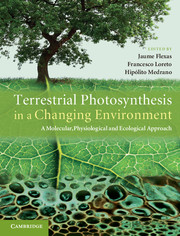 Terrestrial Photosynthesis in a Changing Environment
Terrestrial Photosynthesis in a Changing Environment Book contents
- Frontmatter
- Contents
- List of contributors
- Preface
- Acknowledgements
- List of abbreviations
- 1 Terrestrial photosynthesis in a changing environment
- Part I Photosynthesis
- Part II Measuring photosynthesis
- Part III Photosynthetic response to single environmental factors
- 16 Photosynthetic responses to radiation
- 17 Photosynthetic responses to increased CO2 and air pollutants
- 18 Response of photosynthesis to low temperature
- 19 Photosynthetic responses to high temperature
- 20 Photosynthesis under water deficits, flooding and salinity
- 21 Photosynthetic responses to nutrient deprivation and toxicities
- 22 Photosynthetic responses to biotic stress
- Part IV Photosynthesis in time
- Part V Photosynthesis in space
- Part VI Photosynthesis in a global context
- References
- Index
18 - Response of photosynthesis to low temperature
Published online by Cambridge University Press: 05 March 2013
- Frontmatter
- Contents
- List of contributors
- Preface
- Acknowledgements
- List of abbreviations
- 1 Terrestrial photosynthesis in a changing environment
- Part I Photosynthesis
- Part II Measuring photosynthesis
- Part III Photosynthetic response to single environmental factors
- 16 Photosynthetic responses to radiation
- 17 Photosynthetic responses to increased CO2 and air pollutants
- 18 Response of photosynthesis to low temperature
- 19 Photosynthetic responses to high temperature
- 20 Photosynthesis under water deficits, flooding and salinity
- 21 Photosynthetic responses to nutrient deprivation and toxicities
- 22 Photosynthetic responses to biotic stress
- Part IV Photosynthesis in time
- Part V Photosynthesis in space
- Part VI Photosynthesis in a global context
- References
- Index
Summary
Chilling and freezing temperatures
Low temperatures represent a major abiotic constraint to the distribution, development and productivity of many plant species. Plants have evolved adaptations to cope with chilling or freezing and to be able to acclimate to low temperature (Allen and Ort 2001; Wisniewski et al., 2003; Slot et al., 2005; Ruelland et al., 2009). These include dormancy, rapid acclimation and maintenance of cold hardiness during prolonged low-temperature or freezing periods (Howe et al., 2003; Wisniewski et al., 2003). The responses to chilling differ from the responses to freezing temperatures. In temperate regions, chilling refers to non-freezing temperatures (0–12°C) during the growing season with the lowest temperatures typically occurring during the night (Allen and Ort, 2001). In contrast, freezing or frost requires temperatures below 0°C. Adaptation to freezing includes mechanisms to prevent freezing injuries from the formation of ice inside the plant cell, which would result in deleterious damage or death of the cell (for recent reviews on acclimation to freezing temperatures see Kalberer et al., 2006; Thomashow, 1999; Xin and Browse, 2000). Other mechanisms involved in this process include e.g., changes in lipid composition or the reactive-oxygen-scavenging-system. Together this suite of acclimation responses involving various metabolic, physiological and developmental aspects is called cold hardening or cold acclimation (Xin and Browse, 2000).
The ability of a species to acclimate to low temperatures via the cold hardening process allows one to distinguish cold-hardy from non-hardy plants, e.g., plants that have the genetic capacity to acclimate to chilling or freezing versus plants lacking this genetic information (Allen and Ort, 2001). These cold-hardy plants are typically from cold or temperate environments. Importantly, even cold-tolerant plants are at risk of being killed by low temperatures. For example, unhardened wheat plants, which are genetically adapted to sustain freezing temperatures, will not be able to survive temperatures of –5°C if they are not acclimated to low temperatures through an adequate cold-hardening period (Thomashow, 1999).
- Type
- Chapter
- Information
- Terrestrial Photosynthesis in a Changing EnvironmentA Molecular, Physiological, and Ecological Approach, pp. 272 - 289Publisher: Cambridge University PressPrint publication year: 2012
- 8
- Cited by


